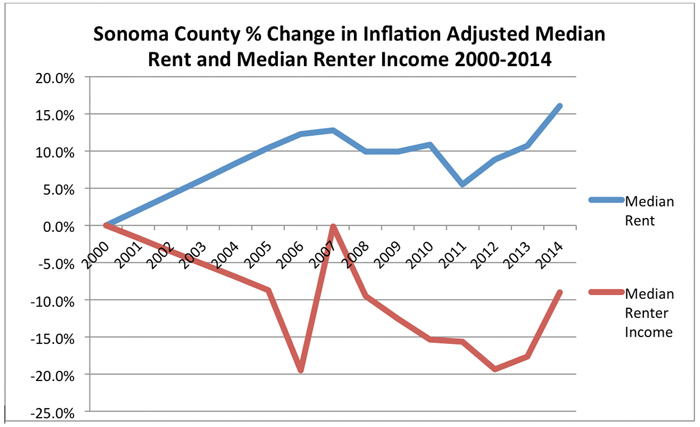
A widening gap between declining incomes and rising rents is fueling two powerful movements in the Golden State: one to raise the wage floor for low-wage workers, and another to control rents and increase funding for affordable housing.
According to the California Housing Partnership Corporation, a combination of falling incomes and high rents is driving the worst rental-housing crisis in California since World War II. Between 2000-2014 in California adjusted median household income fell 8 percent while median rents jumped 20 percent. During this timeframe Sonoma County‘s median renter income dropped by 9 percent and median rents increased by 17 percent.
As a result, a record number of renters in the state and the county cannot afford housing costs. In Sonoma County in 2014, 56 percent of renter households spent more than 30 percent of their income on rent, and 30 percent of county households were severely cost burdened, spending more than 50 percent on rent.
Sonoma County rents have spiked an astonishing 40 percent over the last four years according to Real Answers, a real estate research organization. Of 3,100 homeless county residents in 2015, more than two-thirds claimed in a survey “affordable rent” as the main reason for losing permanent shelter.
The foreclosure crisis, triggered by Wall Street’s predatory and illegal lending practices, targeted working class and minority home buyers and dramatically increased the number of renters, thus pushing rents sky high in most California metropolitan regions.
The rental crisis has only intensified during the economic recovery, due to the Bay Area‘s tech-induced job growth. The result is an influx of highly paid technology workers, and displacement of working-class and low-income renters by landlords seeking higher profits.
Why Falling Incomes and Rising Inequality?
Simultaneous with rising rents, incomes and wages are falling for the majority of California workers.
The most important factor driving income inequality is the "recovery’s" failure to create good jobs. According to the National Employment Law Project, 44 percent of new jobs added in 2010-2014 were low-wage (paying less than $14/hr.); and a record share are part-time and temporary jobs. In contrast, mid-wage jobs paying between $14/hr- $20/hr. are only 20 percent of the new jobs created.
These labor market trends will not change soon. The California Employment Development Department projects that hourly wages for seven of the ten top growth job occupations will be $12 or less in the decade 2012-2022. These new jobs are overwhelmingly clustered in service sector industries such as home care and personal care, childcare, retail sales, and restaurant and food services,
Another major cause of rising inequality and falling wages is the demise of unions. In the mid-1950s, over 40 percent of California workers were union members but today less than 16 percent are in unions. According to the Economic Policy Institute, the wages of union workers average 27 percent higher than nonunion workers.
The falling value of the minimum wage is also a major factor driving inequality. This is due to the legislature’s failure to annually adjust the minimum wage for the rising cost of living. According to the California Budget and Policy Center (CBPC), if the California legislature had adjusted the minimum wage for inflation, since the late 60s, it would have risen above $12.00/hr. in 2015.
Inflation-adjusted wages for the bottom 50 percent of California’s workforce declined between 1979-2013, according to CBPC. Compared to similar workers in 1979, hourly wages for workers earning at the bottom 20 percentile of the wage distribution dropped by 12 percent, while wages for the top 80 percentile increased by 17 percent.
Funding for Affordable Housing Slashed
The declining incomes and rising rents for most Californians since 2000 are accompanied by a sharp drop in funding for affordable housing at every level of government.
According to the Center for Budget and Policy Priorities, the federal government provides Section 8 housing vouchers, the nation’s largest housing subsidy, to 300,000 low-income renters in California (but only 25 percent of eligible renter households actually receive vouchers). Further, in 2013 vouchers were slashed for 15,000 of these renters due to federal budget cuts.
In Sonoma County, the Santa Rosa Press Democrat reported that nearly 30,000 eligible low-income families were on the waiting list for Section 8 vouchers in 2015. Typically, an eligible renter waits eight years for a voucher.
The state also has drastically cut back funding for affordable housing. In 2011 Governor Jerry Brown eliminated local redevelopment agencies that were the state’s main source for affordable housing funding, generating $1 billion annually for moderate and low-income affordable housing. Subsequently the state has created no new sources to fund affordable housing.
Last year, the Governor effectively killed legislation that would have created a dedicated source of funding for affordable housing by increasing taxes on real estate-related documents at the point of sale. Brown also vetoed another bill that would have expanded the state’s low-income tax credits, enabling affordable housing developers to procure more than $1 billion in federal funds.
What is to be Done?
Concerned citizens must continue to press the legislature to pass legislation that will fund affordable housing; for example, AB 2 would create a new form of tax-increment financing for local jurisdictions. We must also lobby cities, like the City of Santa Rosa, to increase funding for affordable housing by implementing a jobs-housing linkage fee for large commercial, retail and industrial development. In 2005-2006, Sonoma County and four of its cities approved such linkage fees.
Rent control is an important component of rent stabilization that all cities in the county should adopt. Twelve California cities have implemented some form of rent control to limit the amount of increase that landlords may annually impose. Numerous California cities such as Alameda, Lafayette, and Santa Rosa, are considering rent control, while Richmond and others may place rent control measures on the ballot.
State law bars rent control on housing built after 1995, single-family homes, and with certain exceptions, permits unlimited rent increases when a tenant moves out. Hence rent control can only be imposed on a limited number of housing units, and in Santa Rosa just 20 percent could be covered.
Fight for $15 and Raising Wages to Pay the Rent
Growing inequality and federal and state governments’ refusal to raise the wage floor has ignited the national “Fight for $15.” This grassroots movement grew from fast-food worker strikes in New York in 2013 and spread to 200 cities in April 2015, when 60,000 fast food, retail, home care, and child care workers walked off their jobs demanding $15 and a union.
The Fight for $15 is rooted in the 2011-2012 Occupy encampments that protested the concentration of wealth by the top 1 percent of Americans, and the living wage movement that began in 1994 in Baltimore. Today, 140 cities, counties, and airports have passed Living Wage Ordinances to mandate that employees of local government and private firms, who work on government contracts,will receive a living wage and become self-sufficient, instead of having to rely on public assistance.
In 2013 Seattle passed the first citywide $15/hr. minimum wage law applied to all low-wage workers in both the private and public sectors. San Francisco then followed in 2014, and Los Angeles moved in 2015 to implement a $15/hr. citywide minimum wage. According to the UCB Labor Center, 30 cities and counties have now implemented $15/hr. minimum wage laws, and 15 are in California.
This rapid spread of citywide minimum wage legislation reflects changing public opinion that, in turn, has influenced labor unions like SEIU to join with faith based, immigrant rights, student, civil rights, and Democratic Party organizations to place a wage initiative on the November ballot. That initiative would raise the California state minimum wage to $15/hr. by 2020. In California, a recent Field poll reveals that 70 percent of the public supports this ballot measure.
Now is the time for affordable housing and higher wage advocates to join together to build a new civil rights movement of the poor to boost the current state minimum wage of $9/hr. to $15/hr. for all. Why? Because the rent can’t wait!
3 WAYS TO SHOW YOUR SUPPORT
- Log in to post comments












